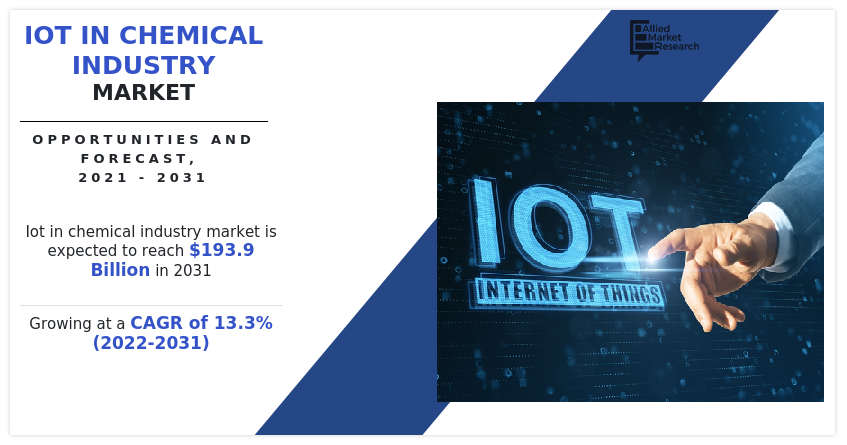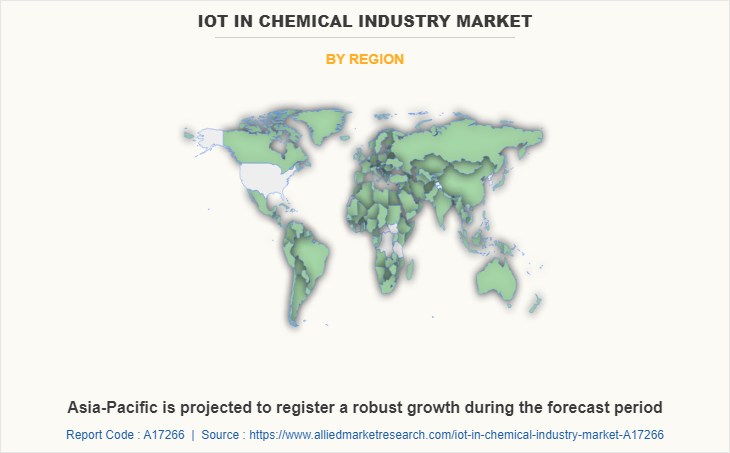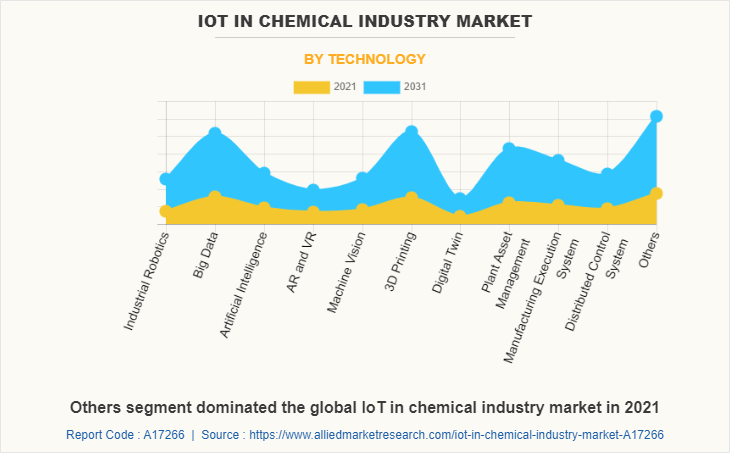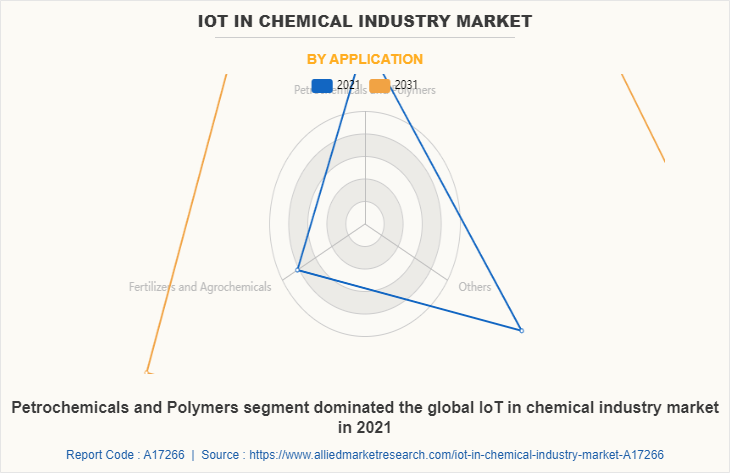IoT In Chemical Industry Market Outlook- 2031
The global iot in chemical industry market size was valued at $57.4 billion in 2021, and is projected to reach $193.9 billion by 2031, growing at a CAGR of 13.3% from 2022 to 2031.
The IoT technology consists of web-connected smart devices that obtain, analyze, and process data collected from their surroundings using embedded systems, including processors, sensors, and communication hardware. IoT in the chemical industry connects all the sensors and other devices to machines to deliver quick and efficient service. It helps in the production of chemicals efficiently.
The growing environmental concerns due to chemical release from the plants, increasing concern towards the reduction of risk associated with chemical industries, and increasing focus on circular economy are expected to serve as crucial growth factors for the IoT in chemical industry market. Also, rise in adoption of industrial robots is further propelling the growth of the IoT in chemical industry market. However, high initial data privacy concern and high initial investment are anticipated to hamper the growth of the IoT in chemical industry market. On the contrary, increased chemical production in developed and developing countries is expected to generate lucrative opportunities for the global IoT in chemical industry market.

The IoT in chemical industry market is segmented into technology type, application, and region. On the basis of technology type, the market is categorized into industrial, big data, artificial intelligence, AR and VR, machine vision, 3D printing, digital twin, plant asset management, manufacturing execution system, distributed control system, and others. On the basis of application, the market is categorized into petrochemicals & polymers, fertilizers & agrochemicals, and others. Region-wise, the market is studied across North America, Europe, Asia-Pacific-Pacific, and LAMEA. The IoT in chemical industry market share is analyzed across all significant regions and countries.
The major players operating in the global IoT in chemical industry market include, ABB Ltd, Altizon, Inc., Atos SE, Cisco Systems, Inc., Emerson Electric Co, Endress+Hauser AG, Fanuc Corporation, General Electric, Honeywell International Inc., Microsoft Corporation, Mitsubishi Electric Corporation, Rockwell Automation, Inc., Schneider Electric SE, Siemens AG, and Yokogawa Electric Corporation.

IoT in Chemical Industry Market By Region
Asia-Pacific is projected to register a robust growth during the forecast period. IoT cloud solution is capable of registration, connection, control, fast visualization, and data storage. It is also required to obtain real-time analysis of user and machine data, such as audio, text, and video utilizing a smart and scalable platform. Cloud computing allows users to access storage, data, software, and servers via internet-connected devices, such as PCs, smartphones, tablets, and wearables. In Asia-Pacific, there is rising chemical production in China, India, Thailand, and Indonesia, along with rising industrialization and urbanization, which is projected to propel the IoT in chemical industry market growth in the region.

IoT in Chemical Industry Market By Technology
Others segment dominated the global IoT in chemical industry market in terms of revenue, in 2021. The other technology types include, programmable logic controller, enterprise resource planning, supervisory control and data acquisition, human machine interface, product lifecycle management, and others. Programmable logic controllers (PLCs) are the brain behind numerous operations in the chemical process industries (CPI). Proper maintenance management of PLCs is needed to avoid damage to machines and personnel, as well as to minimize downtime. Enterprise resource planning help optimize all facets of the organization. It can revolutionize business processes and connect teams on one sophisticated platform.

IoT in Chemical Industry Market By Application
Petrochemicals and Polymers segment dominated the global IoT in chemical industry market in 2021. IoT technology is widely used to deliver innovative solutions for data collection in the traditional petroleum and petrochemical industry to meet the development of the informatization construction of the oil industry and the business needs for cost reduction and efficiency advancement. Moreover, companies nowadays are installing cameras in their super absorbent polymer (SAP) production lines, where deep-learning algorithm is applied that learns behaviors via moving images. This is helping companies to deal with production line shutdown impacted by foreign substances and enhance the efficiency of product inspection.
Key Benefits For Stakeholders
- This report provides a quantitative analysis of the market segments, current trends, estimations, and dynamics of the iot in chemical industry market analysis from 2021 to 2031 to identify the prevailing iot in chemical industry market opportunities.
- The market research is offered along with information related to key drivers, restraints, and opportunities.
- Porter's five forces analysis highlights the potency of buyers and suppliers to enable stakeholders make profit-oriented business decisions and strengthen their supplier-buyer network.
- In-depth analysis of the iot in chemical industry market segmentation assists to determine the prevailing market opportunities.
- Major countries in each region are mapped according to their revenue contribution to the global market.
- Market player positioning facilitates benchmarking and provides a clear understanding of the present position of the market players.
- The report includes the analysis of the regional as well as global iot in chemical industry market trends, key players, market segments, application areas, and market growth strategies.
IoT in Chemical Industry Market Report Highlights
| Aspects | Details |
| By Technology |
|
| By Application |
|
| By Region |
|
| Key Market Players | Honeywell International Inc., ENDRESS+HAUSER AG, General Electric, Siemens AG, Rockwell Automation Inc., Cisco Systems Inc., Yokogawa Electric Corporation, Microsoft Corporation, ALTIZON INC, Emerson Electric Co., Atos SE, SCHNEIDER ELECTRIC SE, FANUC CORPORATION, ABB Ltd, Mitsubishi Electric Corporation |
Analyst Review
According to perspective of CXOs of leading companies, the IoT in chemical industry market is anticipated to grow in the near future due to its extensive use in applications, such as petrochemicals & polymers, specialty chemicals, fertilizers & agrochemicals, consumer chemicals, industrial gases, water management, and others. Also, advancements in technologies such as smart sensors and virtual & augmented reality as well as low operational cost boost the growth of the global IoT in chemical industry market. Increasing need for product visibility in the chemical industry, faster production cycles, higher productivity, lessening the cost of quality management are the primary market drivers that are contributing to the development of the IoT in the chemical industry market. The Asia-Pacific region is projected to register a robust growth during the forecast period.
The IoT in chemical industry market was valued at $57.4 billion in 2021, and is projected to reach $193.9 billion by 2031, growing at a CAGR of 13.3% from 2022 to 2031.
The IoT in chemical industry market was valued at $57.4 billion in 2021, and is projected to reach $193.9 billion by 2031, growing at a CAGR of 13.3% from 2022 to 2031.
The IoT in chemical industry market was valued at $57.4 billion in 2021, and is projected to reach $193.9 billion by 2031, growing at a CAGR of 13.3% from 2022 to 2031.
The growing environmental concerns due to chemical release from the plants, increasing concern towards the reduction of risk associated with chemical industries, and increasing focus on circular economy are expected to serve as crucial growth factors for the IoT in chemical industry market. Also, rise in adoption of industrial robots is further propelling the growth of the IoT in chemical industry market.
The growing environmental concerns due to chemical release from the plants, increasing concern towards the reduction of risk associated with chemical industries, and increasing focus on circular economy are expected to serve as crucial growth factors for the IoT in chemical industry market. Also, rise in adoption of industrial robots is further propelling the growth of the IoT in chemical industry market.
Asia-Pacific is projected to register a robust growth during the forecast period.
Asia-Pacific is projected to register a robust growth during the forecast period.
Asia-Pacific is projected to register a robust growth during the forecast period.
Petrochemicals & Polymers is the leading application of IoT in Chemical Industry Market
Petrochemicals & Polymers is the leading application of IoT in Chemical Industry Market
Petrochemicals & Polymers is the leading application of IoT in Chemical Industry Market
The major players operating in the global IoT in chemical industry market include, ABB Ltd, Altizon, Inc., Atos SE, Cisco Systems, Inc., Emerson Electric Co, Endress+Hauser AG, Fanuc Corporation, General Electric, Honeywell International Inc., Microsoft Corporation, Mitsubishi Electric Corporation, Rockwell Automation, Inc., Schneider Electric SE, Siemens AG, and Yokogawa Electric Corporation. ?
The major players operating in the global IoT in chemical industry market include, ABB Ltd, Altizon, Inc., Atos SE, Cisco Systems, Inc., Emerson Electric Co, Endress+Hauser AG, Fanuc Corporation, General Electric, Honeywell International Inc., Microsoft Corporation, Mitsubishi Electric Corporation, Rockwell Automation, Inc., Schneider Electric SE, Siemens AG, and Yokogawa Electric Corporation. ?
The major players operating in the global IoT in chemical industry market include, ABB Ltd, Altizon, Inc., Atos SE, Cisco Systems, Inc., Emerson Electric Co, Endress+Hauser AG, Fanuc Corporation, General Electric, Honeywell International Inc., Microsoft Corporation, Mitsubishi Electric Corporation, Rockwell Automation, Inc., Schneider Electric SE, Siemens AG, and Yokogawa Electric Corporation. ?
Loading Table Of Content...


